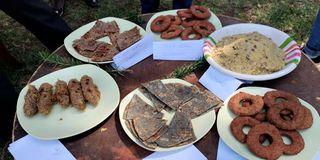New bean variety to help fight malnutrition

Value added products made from beans displayed in Nyeri County.
What you need to know:
- The hidden hunger, according to specialists, is the lack of zinc and iron in the food that we consume.
- The two elements not only account for proper development of children, but also plays a pivotal role in the wellbeing of adults.
Whereas Kenya is fighting the adverse effects of famine, there is ‘hidden hunger’ that normally goes unnoticed and whose impact is manifested through stunted growth and malnourishment in children.
The hidden hunger, according to specialists, is the lack of zinc and iron in the food that we consume. The two elements not only account for proper development of children, but also plays a pivotal role in the wellbeing of adults.
It is against this backdrop that scientists have come up with a new project dubbed Zyron pulse, which is aimed at promoting bean varieties that are high in zinc and iron.
The varieties include Angaza, Faida, Cheupe, Nyota and Kenya Madini.
The beans are highly recommended for pregnant and breastfeeding mothers and children under the age of five to ensure they have sufficient amounts of zinc and iron in their bodies.
The innovation is an initiative of the Kenya Agriculture Livestock and Research Organisation (Kalro) and the University of Nairobi — brains behind breeding of these beans— and the Food Agriculture and Natural Resources Policy Analysis Network (FANRPAN), which is promoting the nutritional component.
Beatrice Kiage, a nutritional lecturer at Jomo Kenyatta University of Agriculture and Technology and a representative of the FANRPAN, noted that once an expectant mother consumes the beans, the foetus in her body gets sufficient iron and zinc, contributing immensely to its growth.
“You can be full but you are still hungry because you do not have iron and zinc. This is a big concern given that a third of Kenyan population suffers from stunted growth for lack of these elements,” said Dr Kiage.
Dr Kiage said they are especially promoting the uptake of Ziron beans in rural Kenya, where malnutrition is rampant. “These beans offer a window of opportunity to address chronic malnutrition in the country and we want to ensure that all families get access to this cheap but quality meal that is readily available,” she said.
She said lack of zinc and iron in children does not only result to stunted growth but also affects their cognitive ability. “Lack of these nutrients does not only affect their physical stature but also their IQ level, which goes down by 11 per cent,” she said.
James Horton Institute in the United Kingdom is funding the project to ensure that the malnutrition crisis in Kenya is addressed. Beans are among the highly consumed cereals in the country and Kenya is the second largest producer of the commodity in Africa after Rwanda. However, the country still records a deficit of 100,000 tonnes from the current production of 600,000 tonnes.
The government through Kalro is distributing the seeds to farmers.
Carolyne Mwenze, a crops officer in Naromoru sub-county, says the new variety takes a shorter time to mature and most of them are drought tolerant.
“These beans mature in under three months and they play a key role in mitigating the effects of the climate change given that they can withstand harsh climatic conditions. A two kilo packet of these beans sells for Sh260. “
To encourage consumption of this cereal, FANRPAN is also promoting value addition that has seen rural communities empowered to make chapati, kebabs, cookies and cakes from this new variety.
Beans in Kenya are largely mixed with maize to make githeri, which is synonymous with a lot of Kenya’s households. This initiative is moving beyond having beans for githeri and is now promoting value addition.
“We can make more than 40 recipes from the bean and this will play a key role in promoting its consumption as we have a lot of people, including children who do not like taking beans in their original form,” Dr Kiage said.





